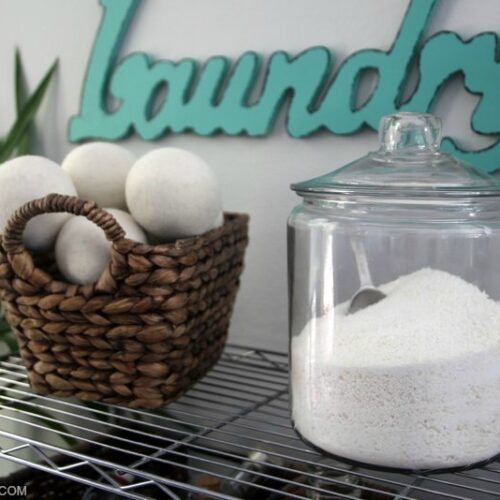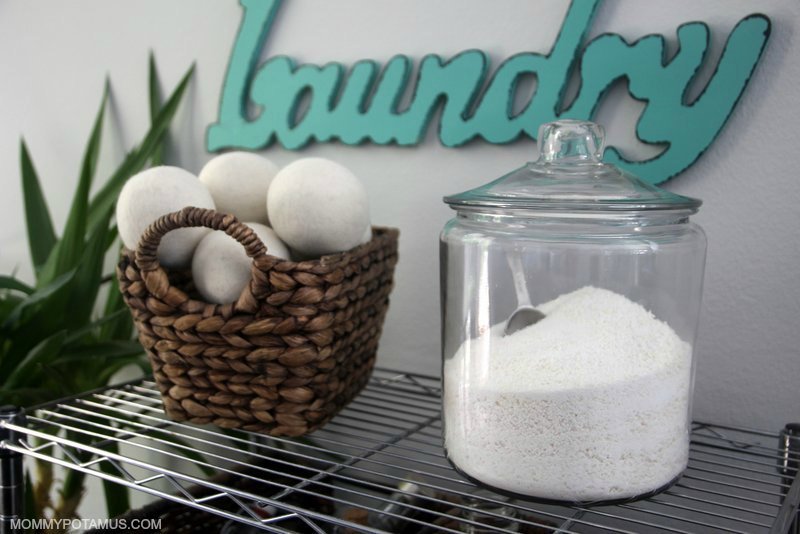
Have I ever told you about the time I washed newborn clothes with the tags and hangers still on? Or the time my preschooler decided to “help” with the laundry by adding a load of cloth diapers to my freshly cleaned whites?
Personally, I’m not up for adding complications to my laundry routine, which is why I love this easy homemade laundry detergent.
It’s super simple to make and has received a lot of positive feedback, like this comment from Hillary:
I washed a couple loads of laundry today- and it worked so well! Our laundry is always SUPER dirty too! My husband does mechanical work for a logging company and his clothes get REALLY dirty after crawling in, on, and under those greasy machines! I think the detergent cleaned it better than our natural detergent we were buying from Costco! I was very impressed, thank you! : )”
And this one from Cee:
Yay for this laundry soap!! It actually works and is so simple! I haven’t got into making soap yet but I buy bulk bags of soap odds and ends from when I buy my hair shampoo bars and it’s the best natural detergent yet! Thank you so much!”
Before we dive into the recipe, I’ve updated this article to answer some of the most commonly asked questions I’ve received over the years.
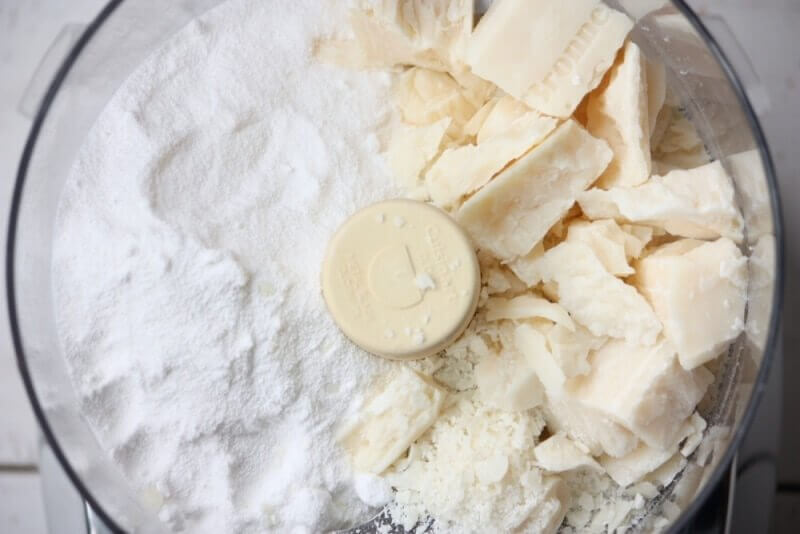
What’s the difference between laundry detergent and laundry soap?
According to Chris Woodford, who holds a masters in Natural Sciences from Cambridge University:
Often we use the words ‘soap’ and ‘detergent’ interchangeably, but really they’re quite different things. A detergent is a chemical substance you use to break up and remove grease and grime, while soap is simply one kind of detergent.” (1)
Detergents can be made from other things, too, like natural or synthetic compounds that help separate dirt from fabrics using the same mechanism as soap. Both work by reducing the surface tension of water, which loosens dirt so that it can wash away.
Bottom Line: According to Woodford, all soaps are detergents but not all detergents are soaps.
I call this recipe laundry detergent because that seems to be the name most people recognize, but it could just as easily be called homemade laundry soap.
Why make your own laundry detergent?
As I wrote about here, a University of Washington study of some of the top-selling laundry products and air fresheners found that they all emitted at least one chemical regulated as toxic or hazardous under federal laws. (source)
Interestingly, none of the chemicals were listed on the label, and five of the six products emitted chemicals which are considered by the Environmental Protection Agency to have no safe exposure level.
Fortunately, in the past few years several companies have begun offering non-toxic options that work well – I’ll cover those later in the article.
Although I do buy laundry detergent every once in awhile, I like making my own because it’s an easy way to save money on household expenses.
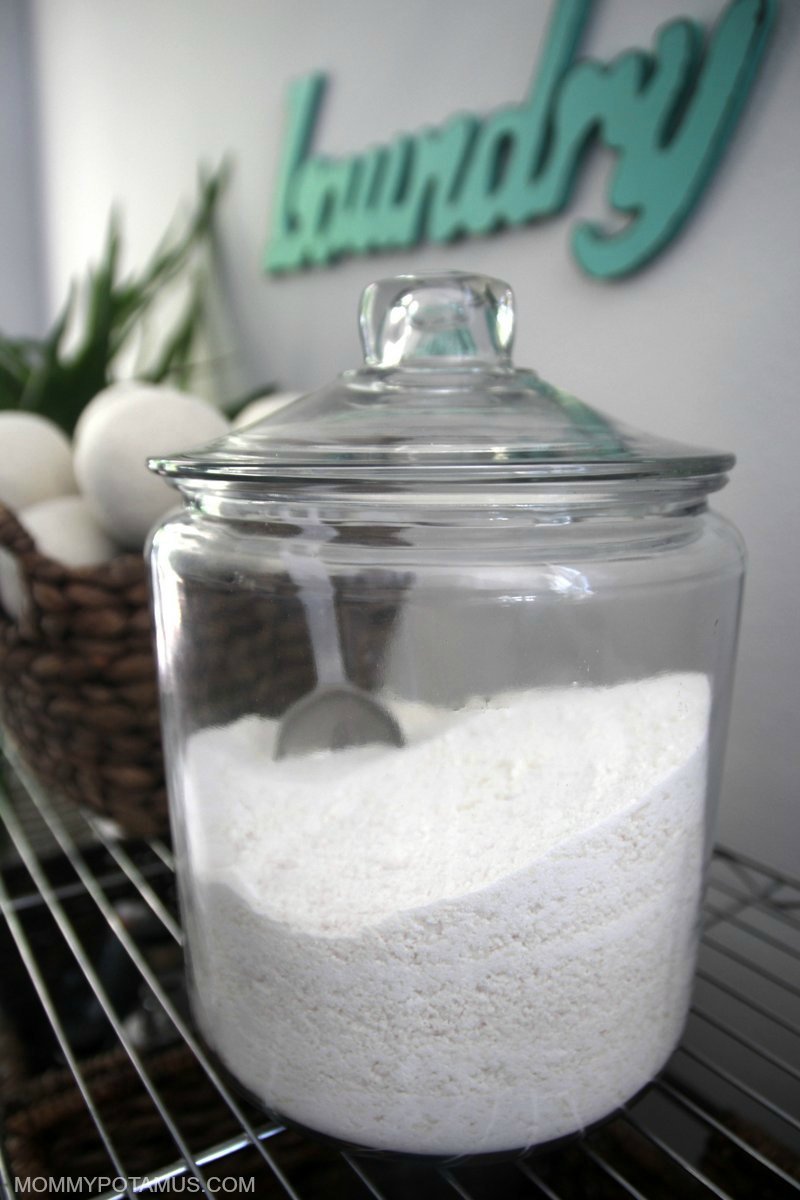
Homemade Laundry Detergent: What You Really Need
If you’ve ever searched around for laundry detergent recipes online, you’ve probably seen ones that have five, six or even seven ingredients. It may seem like they’d be more effective than ones with just two or three, but simplicity really does work in our favor here.
That’s because instead of mixing a weaker ingredient with a stronger one, I just use the more effective of the two. For example, according to this post, “Baking soda is only half as strong as washing soda at softening water and doesn’t allow the cleaning pH to go nearly as high. And if you have a stronger product on hand, why dilute it with a weaker one?”
No one uses baking soda in commercial formulas. . . not even Arm & Hammer! With that in mind, here are my essentials for making homemade laundry powder:
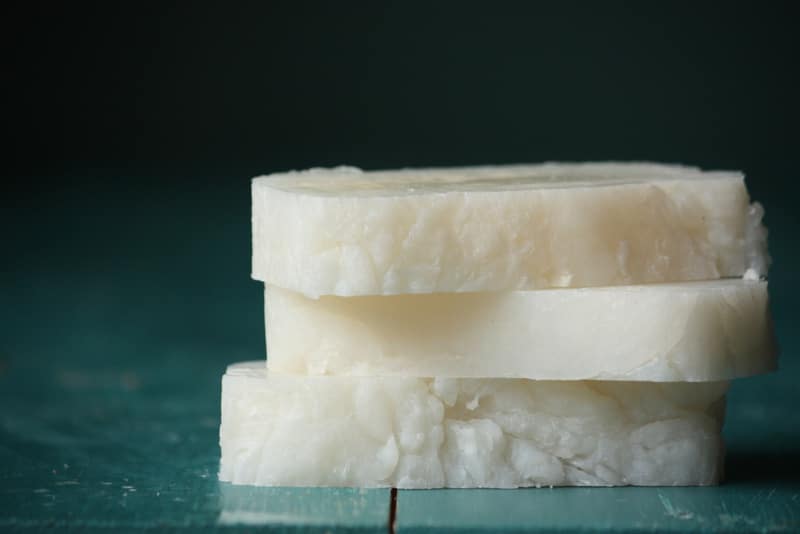
Bar Soap
There are two basic kinds of soap:
- Body Bar Soap – Soap can dry skin out, so manufacturers add in a little extra oil to condition skin while cleansing it. This is the idea behind Ivory soap’s “one-quarter moisturizing cream in every bar” campaign.
- Laundry Soap – While extra oil is great for skin, it can cause buildup over time when used to wash clothes. That’s why most laundry detergent recipes suggest using soaps that are specifically made for laundry care and don’t contain extra oil. Two of the most popular are Fels Naptha and Zote bar soap, however both contain ingredients that I prefer not to use.
With that in mind, here are my top bar soap options in order from good to best.
Dr. Bronner’s Castile Soap (Good) – Made with clean ingredients, this soap is widely available and works well for many. Depending on the type of water you have it **may** cause buildup over time, but then again it may not. I use it on occasion when I don’t have my best option on hand, and it’s worked well for me.
Kirk’s Castile Soap (Better) – This bar is made from coconut oil, which has got serious cleaning power when made into soap. It does have a little extra moisturizing oomph because it’s intended for skin, but it’s worked beautifully for me as a laundry bar.
Pure Coconut Oil Soap (Best) – This three-ingredient homemade soap is my favorite because it doesn’t contain lots of added oil for moisturizing purposes. It’s easy to make and has excellent cleaning power.
Pure Tallow Soap Flakes (Best) – This is my top store-bought option. I don’t know how they source their tallow but the ingredients are good overall.
Washing Soda
Found in a lot of commercial detergents, washing soda helps to degrease and deep clean clothes. It also helps by binding to minerals that can prevent the soap you’re using from getting into laundry fibers and doing their job.
If you have it on hand, you can make washing soda from baking soda with this method.
Lemon Essential Oil (Optional)
Works well as a stain remover and degreaser.
Optional Additions
Although not part of the main recipe, here are some additions worth considering:
Vinegar
I add 1/2 cup white vinegar to each load for two reasons:
- Laundry detergent has a very alkaline pH, which can irritate skin. Using a vinegar rinse resets the pH to a skin-friendly level.
- It helps dissolve excess detergent and salts off clothes.
The easiest way I’ve found is just to add it to a Downy ball so that it releases after the initial wash cycle.
Powdered Oxygen Bleach Without Fillers
There are several chlorine-free bleach alternatives that are great for brightening, whitening, and deodorizing. Here are my top picks:
- Eco-Me Laundry Whitener and Brightener – Safe for colors and whites. Add one capful along with your laundry detergent to loads as needed.
- Molly’s Suds Oxygen Whitener – Safe for colors and whites. Add one scoop along with your laundry detergent to loads as needed.
- Pure Sodium Percarbonate (powdered hydrogen peroxide) – Safe for whites and colors when you add a couple of tablespoons to your regular wash cycle. May fade some colors if soaked for hours. The brand I link to says it contains 99% pure sodium percarbonate, but it’s totally pure. The other 1% is moisture.
Homemade Laundry Detergent Recipe (Borax-Free)
Equipment
- cheese grater
Ingredients
- 6 cup washing soda (where to buy washing soda, how to make your own)
- 3 bars of bars of 4.5 - 5 ounce soap, finely grated (See the "Bar Soap" section above for recommendations. Can also use approximately one pound of soap flakes.)
- 100-150 drops lemon essential oil (optional)
Additional Items You Might Want To Have On Hand
- white vinegar
- powdered oxygen bleach
- Downy ball
- wool dryer balls (where to buy them, how to make your own)
Instructions
To Make Homemade Laundry Detergent
-
Grate the soap with a cheese grater.
-
Add the grated soap, washing soda and essential oil (if using) to your food processor.
-
Blend until you have a fine powder. You may want to lay a dish towel over the top of your food processor to prevent a fine mist of powder from floating into the air. Also, let it settle a bit before opening the container or the powder will float onto your kitchen counter.
-
Pour into a clean, airtight container.
To Use Your Homemade Laundry Detergent (Top Loading Machine)
-
Add 3 tablespoons laundry detergent per load. If you are washing in cold water, dissolve it in hot water before adding it in. I prefer to start each load with a little hot water to dissolve and then put my laundry in.
-
Optional Step: Add 2 tablespoons of powdered oxygen bleach to your load.
-
Optional Step: Add 1/2 cup vinegar to a Downy ball or the fabric softener compartment.
-
Optional Step: For extra fabric softening goodness and a shorter drying time, toss some wool dryer balls in the dryer with your clothes. They're an eco-friendly, reusable alternative to dryer sheets.
Notes
- As with other detergents, it is recommended that you cut the amount used in half for HE machines.
- Be sure to check your owner’s manual - using certain types of laundry products in your HE machine may void your warranty. See the FAQ section below for more information.
What To Buy If You Don’t Want To DIY
When you’d rather not make your own, here are some great options to consider:
- Nature Clean
- Attitude
- Eco Me in Citrus Berry, Lavender, Vanilla Bean and Fragrance-Free
- Better Life in Unscented and Lavender Grapefruit
- Molly’s Suds Laundry Powder is very similar to my recipe below and comes in unscented and peppermint.
- Meliora Laundry Powder is also similar and comes in Unscented, Lemon and Lavender.
- Sapadilla comes in Rosemary + Peppermint, Grapefruit + Bergamot, and Lavender + Lime
Frequently Asked Questions
Since I first posted this recipe there have been hundreds of questions (and counting) posted in the comments. Here are the answer to the most common ones.
Is this laundry detergent HE safe?
This soap is low-sudsing, so theoretically it should be fine for HE washers. A very similar recipe found on the Kirk’s Castile Soap website is said to be safe and offers the following information and tips:
- “This powered recipe is great for High Efficiency washers because it is very low sudsing.
- It is important that you grate the bar soap very finely for HE washers.”[i]
With that said, be sure to check your owner’s manual, because some manufacturers will void your warranty if you don’t use detergent made specifically for HE washers.
Keep in mind that just like with other products, it is suggested that you cut the amount used in half for HE machines.
Is this homemade detergent septic system safe?
Yes, all of the ingredients in this recipe are considered septic system safe.
Can I mix this with water to make liquid laundry detergent?
From what I’ve read, homemade liquid detergents made with washing soda tend to lose potency rather quickly so I don’t use them.
Is this recipe good for sensitive skin?
In my experience, yes. I used it when my babies were small and it never irritated their skin.
Does this recipe work for cloth diapers?
I used it with my cloth diapers. The vinegar rinse I mention in the instructions seems to keep them from needing to be stripped very often. However, I will say that only seems to work with natural fibers like cotton and bamboo. I tried it with some microfiber diapers I had back in the day and it “set” the stink rather than washing it out.
Do you know of a healthy alternative to dryer sheets?
Yes, wool dryer balls!
Do you recommend any stain removers?
I have a stain remover recipe here, and this is a great store-bought option.
Now that I have washing soda, what else can I do with it?
Make homemade dishwasher detergent!
Want a FREE ebook of non-toxic cleaning recipes that WORK?
I’ve created a free ebook for you as a gift for signing up for my newsletter. 7 Non-Toxic Cleaning Recipes That Really Work covers seven recipes that you can make in just a few minutes each for squeaky clean windows, sparkling dinnerware, lemon-fresh countertops, and more. Subscribe to my newsletter below and you’ll be redirected to a download page for immediate access to this PDF ebook.
Sources
1. Woodford, Chris (2019) Detergents and Soaps
2. Science Daily (2008) Toxic Chemicals Found In Common Scented Laundry Products, Air Fresheners
Continue reading How To Make Natural Laundry Detergent (Borax-Free)...

